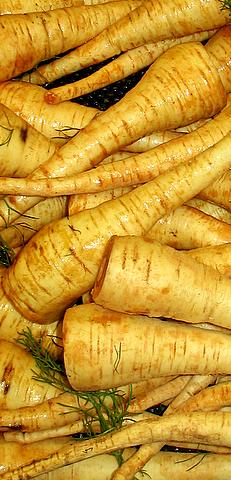Pastinaca
Pastinaca, commonly known as parsnip, is a genus of flowering plant in the family Apiaceae. The most well-known species within this genus is Pastinaca sativa, the garden parsnip, which is a root vegetable native to Eurasia. Parsnips have been cultivated since ancient times for their sweet, edible roots. The plant is biennial, featuring a rosette of leaves in its first year and a flowering stem in its second year. Parsnips are closely related to other vegetables and herbs in the Apiaceae family, such as carrots, celery, and parsley.
Description[edit | edit source]
Pastinaca sativa grows as a biennial plant, typically reaching heights of up to 1 meter. In its first year, it focuses on root growth, producing a thick, white root that is harvested for culinary use. The leaves are compound, with broad, flat leaflets that are arranged in a pinnate manner. During its second year, Pastinaca sativa produces a flowering stem, topped with yellow flowers arranged in umbels. These flowers are hermaphroditic, meaning they have both male and female reproductive parts, and are pollinated by insects.
Cultivation[edit | edit source]
Parsnips prefer cooler climates and are planted in early spring or late summer. They require well-drained soil and a full sun location. The roots are typically ready for harvest after the first frost in autumn, as the cold temperature enhances their sweetness. Parsnips can be left in the ground through the winter and harvested as needed, although they should be lifted before new growth starts in spring to avoid woodiness.
Culinary Uses[edit | edit source]
The root of the parsnip is the most commonly used part of the plant. It has a sweet, nutty flavor, especially when cooked, which makes it a popular ingredient in soups, stews, and side dishes. Parsnips can be roasted, boiled, mashed, or used in baking. They are also a source of dietary fiber, vitamins, and minerals, particularly when eaten with their skin.
Historical Significance[edit | edit source]
Parsnips have been cultivated for their roots since antiquity. Before the introduction of the potato from the New World, parsnips were a staple food in Europe. They were used to make sweeteners before the widespread availability of cane sugar.
Potential Risks[edit | edit source]
While the root of the parsnip is edible, the leaves and the rest of the plant contain furanocoumarins, compounds that can cause skin irritation and photosensitivity. Care should be taken when handling the foliage to avoid phytophotodermatitis, a condition where skin becomes overly sensitive to sunlight.
Varieties[edit | edit source]
There are several cultivars of Pastinaca sativa developed for their root size, shape, and sweetness. These include 'Hollow Crown', 'Gladiator', and 'Tender and True', among others. Breeding efforts continue to improve disease resistance, flavor, and storage qualities.
Conservation and Biodiversity[edit | edit source]
While Pastinaca sativa is widely cultivated, wild populations of parsnips and other Pastinaca species are subject to conservation concerns. Habitat loss and competition from invasive species can threaten these plants. Efforts to conserve Pastinaca species focus on preserving their natural habitats and maintaining biodiversity.
Search WikiMD
Ad.Tired of being Overweight? Try W8MD's physician weight loss program.
Semaglutide (Ozempic / Wegovy and Tirzepatide (Mounjaro / Zepbound) available.
Advertise on WikiMD
|
WikiMD's Wellness Encyclopedia |
| Let Food Be Thy Medicine Medicine Thy Food - Hippocrates |
Translate this page: - East Asian
中文,
日本,
한국어,
South Asian
हिन्दी,
தமிழ்,
తెలుగు,
Urdu,
ಕನ್ನಡ,
Southeast Asian
Indonesian,
Vietnamese,
Thai,
မြန်မာဘာသာ,
বাংলা
European
español,
Deutsch,
français,
Greek,
português do Brasil,
polski,
română,
русский,
Nederlands,
norsk,
svenska,
suomi,
Italian
Middle Eastern & African
عربى,
Turkish,
Persian,
Hebrew,
Afrikaans,
isiZulu,
Kiswahili,
Other
Bulgarian,
Hungarian,
Czech,
Swedish,
മലയാളം,
मराठी,
ਪੰਜਾਬੀ,
ગુજરાતી,
Portuguese,
Ukrainian
Medical Disclaimer: WikiMD is not a substitute for professional medical advice. The information on WikiMD is provided as an information resource only, may be incorrect, outdated or misleading, and is not to be used or relied on for any diagnostic or treatment purposes. Please consult your health care provider before making any healthcare decisions or for guidance about a specific medical condition. WikiMD expressly disclaims responsibility, and shall have no liability, for any damages, loss, injury, or liability whatsoever suffered as a result of your reliance on the information contained in this site. By visiting this site you agree to the foregoing terms and conditions, which may from time to time be changed or supplemented by WikiMD. If you do not agree to the foregoing terms and conditions, you should not enter or use this site. See full disclaimer.
Credits:Most images are courtesy of Wikimedia commons, and templates, categories Wikipedia, licensed under CC BY SA or similar.
Contributors: Prab R. Tumpati, MD

